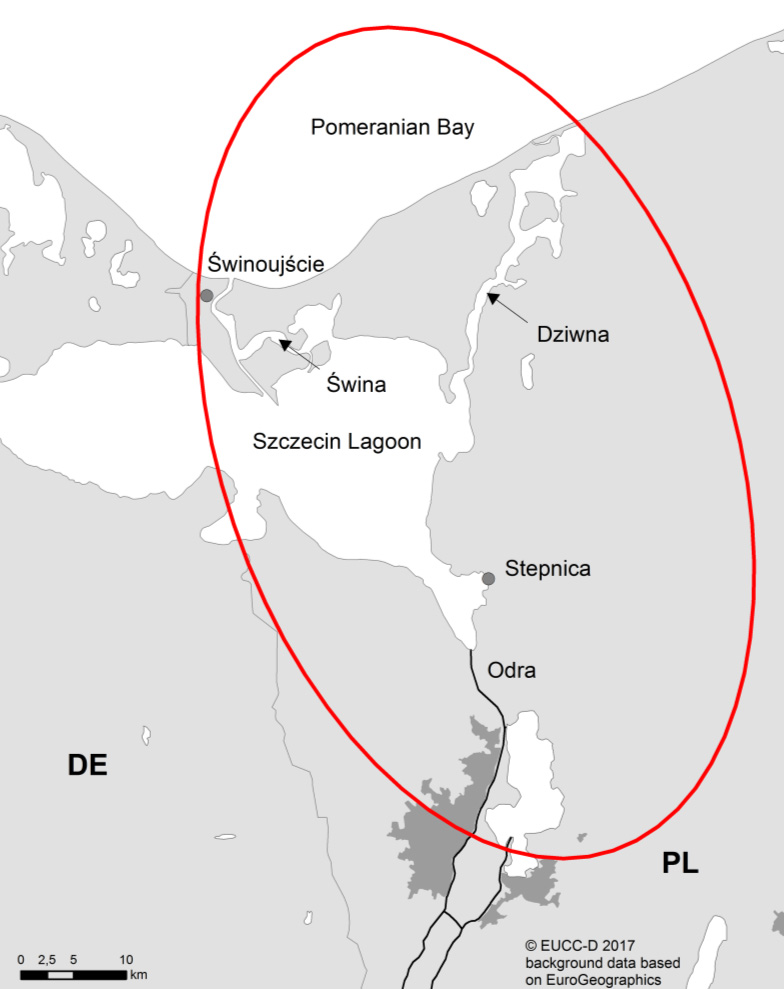Case study: The Szczecin Shoreland, Poland
The case study will provide an overview of the current state of coastal angling tourism at the popular southwest coast of Poland, which can then be used to support the sustainable development of coastal angling tourism in Poland.
Location of study sites: The Szczecin Shoreland (the westernmost part of the Polish coast) occupies territories around the Szczecin Lagoon, the estuary of the Odra River and Pomeranian Bay shores. The study site Pomeranian Bay includes the Polish part of the bay, reaching from the city of Świnoujście to the lighthouse in Gąski. The Szczecin Lagoon is the most southern, coastal bay of the Baltic Sea. The Polish part covers about 410 km2 and includes several lakes and lagoons as well as the straits Świna and Dziwna. The river Odra flows into the lagoon, so that the area becomes part of the extensive estuary system. The lagoon is connected with the Baltic Sea through the 3 straits. As a result of difficult water exchange with the sea, the water reservoir belongs to the brackish waters. The average salinity lies between 0.5 and 2 psu, nevertheless sometimes more salt water penetrates the Świna raising the salinity to 6 psu. Its natural average depth is 3.8 meters. The depth of shipping channels however can exceed 10.5 meters.
Target fish species:
- Szczecin Lagoon: perch, pikeperch, pike, bream and asp
Pomeranian Bay: cod, garfish, sea trout and some flat fish - Main angling season: The main angling season in the Szczecin Lagoon for perch begins in mid-September. Pikeperch is targeted by anglers in Szczecin Lagoon from mid-October until the water is frozen. Afterwards both species can be caught via ice fishing. Pike can be angled from October till November. The main season for angling garfish is in the middle of May. Cod can be caught the whole year, but especially in early spring and late autumn. The angling season for sea trout in the Pomeranian Bay starts at the 15th of November.
Kinds of angling: At Szczecin Lagoon float angling as well as feeder, casting and trolling are popular kinds of angling. In the Pomeranian Bay surfcasting and trolling are the main kinds of angling.
Target group (customers): Due to the lack of recorded data the target group of coastal angling tourism in the study areas is not defined yet. Thus, it is important to reach out to anglers, tourism providers, accommodation providers, local tourism associations, boat rentals, stores for anglers, municipality representatives and scientific authorities in order to gather data.
Available infrastructure: Tourist information centers, common accommodation, restaurants, boat rentals and angling shops
Development of angling tourism: Due to the lack of data, the development of coastal angling tourism in the study areas was not recorded.
Points of sustainability:
- The only sustainability rules connected with coastal angling in Poland refer to ecological aspects (closed seasons and protected areas). Thus, one of the most important outcomes of the CATCH project are sustainable coastal anglers rules, referring to social and economic aspects.
- Several regulations concerning closed seasons, the minimum length of the targeted fish species and the maximum catch quota per day were established, according to the regulation of the Minister of Agriculture and Rural Development dated on the 6th pf July 2015, applying to perch, pike, roach, bream, asp, pikeperch and sea trout.
Known problems: A central system for collection of coastal angling statistical data is lacking (e.g. recreational angling catch data). Moreover, conflicts with other coastal users are an issue (e.g. occupational fishermen).
Marketing slogan: “Pol. Zachodniopomorskie – Morze Przygody” (West Pomerania – Sea of Adventure) Website: www.morzeprzygody.eu
Contact: Jakub Skorupski, , Green Federation “GAJA” Radosław Brzeziński, , Green Federation “GAJA” Aneta Kozłowska, , Green Federation “GAJA”

